Branded vs Non Branded Keywords | Analyze With Google Search Console
Working on SEO can sometimes seem overwhelming. After all, there is so much that can be done and so many different ways to measure success. One of the most helpful places to start is understanding branded vs non branded keywords, and knowing how to analyze both with Google Search Console.
What Are Branded Keywords?
Branded keywords are search terms from customers and prospects who are actively looking for your company (your “brand”).
If you’re working for coffee behemoth Starbucks, keywords like “starbucks”, “starbucks coupons”, “starbucks hours”, “closest starbucks near me”, and “starbucks in raleigh” would all be branded keywords that in aggregate make up a total inbound traffic stream of “branded organic search”.
What Are Non Branded Keywords?
Nonbranded keywords are search terms from customers and prospects who are looking for something related to your company, but are not actively searching for your company itself. In the case of our coffee example, keywords like “coffee”, “coffee shop near me”, “coffee shops with free wi-fi”, “closest coffee to me”, and “best coffee shops in raleigh” would all be non branded keywords that in aggregate make up a total inbound traffic stream of “non-brand organic search”.
Check the end of this blog for some tips on getting more non-branded organic traffic, or keep reading immediately below for more on branded vs non branded keywords.
What’s the Difference in “Value” Between Branded vs Non Branded Keywords?
Branded keyword searches are high intent and more likely to convert than nonbranded keywords. In other words, these prospects have pretty much made up their made that company X is the right provider of the service, product (or latte) that they are looking for, and they are more likely to be in a conversion phase rather than a research phase.
In terms of thinking about the value of organic traffic to an organization, branded keyword search is valuable viewed through this lens. However, SEO isn’t really winning new eyeballs for the company in this way. After all, these people were already thinking about the company. In this view, branded keyword traffic can be thought of more as an assessment of the overall quality of the company’s perception in the market (including other marketing efforts) rather than something that can be used to assess the performance of SEO efforts.
Unlike a branded keyword search, a nonbranded keyword search query indicates someone who is interested in a given product or service but doesn’t have a predetermined business in mind. This is where SEO efforts can prove their value by winning new eyeballs and conversions from prospects who were not already loyal customers.
More Considerations For Branded vs Non Branded Keywords
In the case of a complicated B2B purchase, a non-branded search query could very well drive an organic search click that marks the start of a long customer journey resulting in a lucrative new software contract. In the case of our coffee example, whichever coffee purveyor wins the SERP (search engine results page) with the best placement is likely to reap the benefits of a coffee purchase within the next 30 minutes. Understanding the value of these searches relies on the length of the journeys your customers take before converting, and the ultimate value of that conversion.
The winner of the search result for a non-branded search query like “coffee near me” is going to have a strong Local SEO presence and is also likely to have benefited from SEO copywriting principles on their website. But how can we measure the relative share of brand vs. non-brand organic search to help us understand and plan our future efforts? That’s where Google Search Console comes in.
How Can Google Search Console Measure Both Types of Queries?
To be able to use Google Search Console (GSC) for this analysis, you must have access to a web property within Search Console. As long as that’s the case, follow the steps below.
6 Steps to Search Query Insights in Google Search Console
- #1 – Access the ‘Performance’ reporting section in GSC from the left-hand navigation. This is the default view when logging in to Search Console.
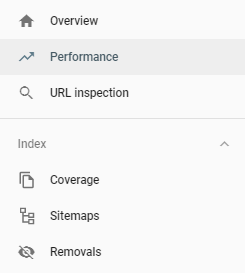
- #2 – Hit the “+ NEW” button to add a new query filter, which is immediately to the right of where the time frame filter of the performance report is displayed.

- #3- Select “Queries containing” if you want to isolate the performance of branded organic search or “Queries not containing” to isolate non-brand organic search. See screenshot below.
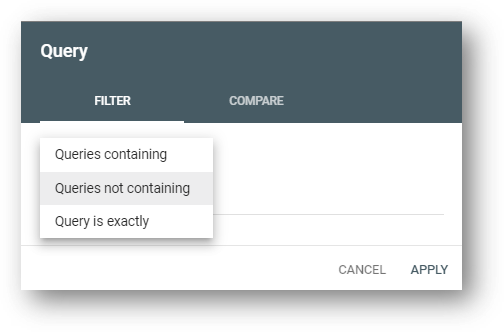
- #4- In the blank “Keyword” field, enter several letters that are representative of the most common name of your organization. For example, if your business is called Black Button Distilling Company (makers of a delicious 4 Grain Bourbon), you could enter “black.”
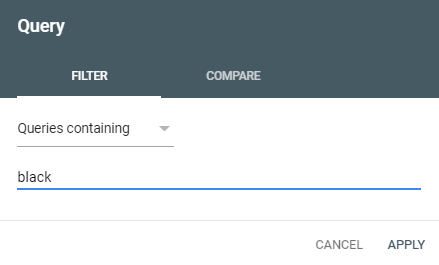
- #5 – Hit “APPLY” and you’re now viewing only the branded search terms or the non-branded search terms (depending on whether you used “queries containing” or “queries not containing” in your filter in step 3).
- #6 – Use “Compare” within your date range filter to view trended performance in your brand or non-brand organic search performance in terms of Clicks and Impressions. I personally like to view the last 3 months year over year, as it accounts for seasonality, but use whatever time frame makes the most sense for your business.
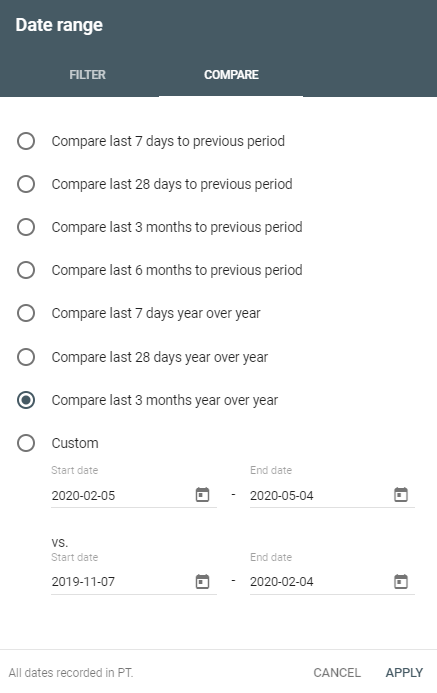
Record your data and analyze in Google Sheets or Excel as shown in the sample analyses below to understand trended performance over the time period you selected.
[For more cool stuff you can do with Search Console, check out this 2 minute YouTube video to learn how you can see all the search queries you’re ranking for with questions including Who, What, When, Where, Why, and How. Check the description for the filter you can copy and paste into Search Console!]
Sample Search Analysis #1: Branded and Non Branded Search Trending At the Same Growth Rates
Here’s an example from a business that has seen traffic both Branded and Non Branded Search increasing at the same rate. As you can see in the table below, “Client A” has grown Branded Search impressions +107.0% year over year and Branded Search Clicks +281.3%. Non-Branded Search has grown at a slightly slower rate in terms of Impressions (+83.9%) and a slightly faster rate for Clicks (+285.4%).
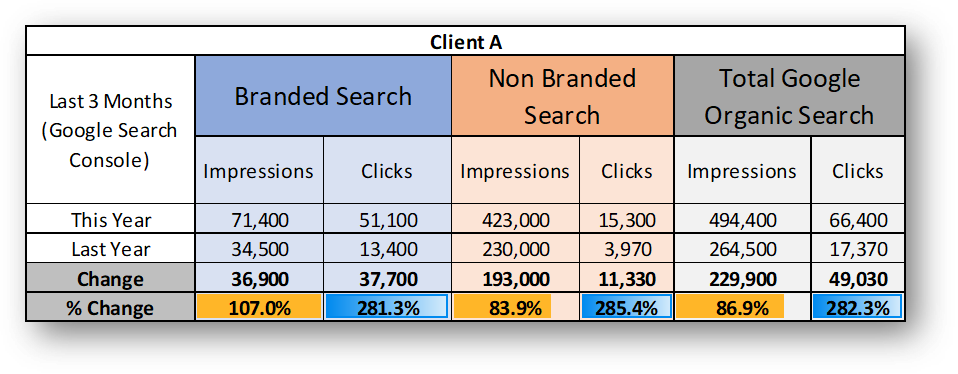
If we calculate the share of organic search, we see that Branded Search Clicks are essentially flat in terms of year over year share (77.0% vs. 77.1% LY), while Non Branded search share has also stayed roughly flat at just under a quarter of all organic search click volume.
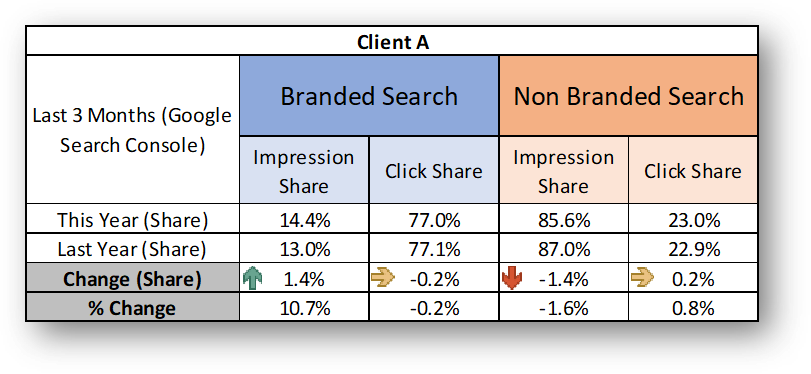
Sample Search Analysis #2: Non Branded Search Growth Outpacing Branded Search
Here’s an example from a business that has seen Non Branded search growing faster than Branded Search. As you can see in the table below, “Client B” has grown Branded Search impressions +23.4% year over year and Branded Search Clicks +204.0%. Non-Branded Search has grown at a much faster rate in terms of Impressions (+166.3%) and faster rate for Clicks (+258.6%).
While not in the scope of this exercise, we’d immediately start thinking about potential implications for these differences. On the Branded search side, we’d feel great about our strong growth in clicks. With impressions only increasing slightly, we’ve done great work in getting more of these high intent searches to result in clicks. We also might feel a bit concerned about the relatively slow rate of growth in those impressions and would consider some type of upper funnel campaign (digital display or social media awareness, perhaps) to drive more brand awareness in the market.
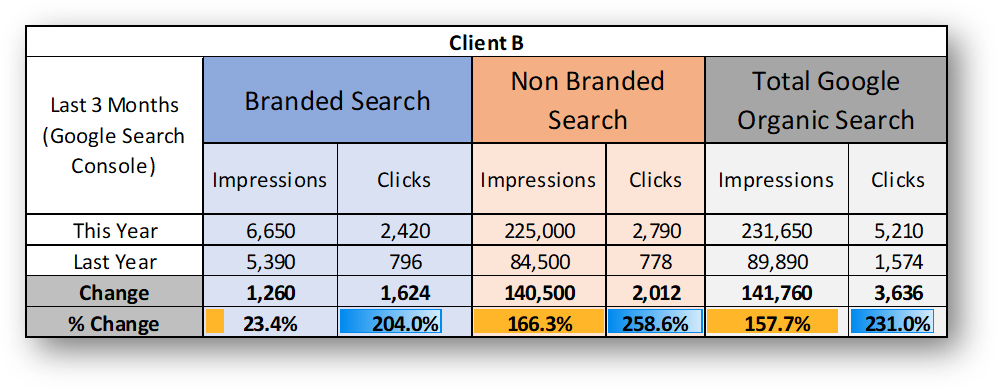
If we calculate the share of organic search, we see that Non Branded Search accounts for a staggering 97.1% of all impressions (up from 94.0% in the prior year) and that the click share of Non Branded Search has risen to 53.6% of total organic traffic clicks. It seems like the SEO-focused blog efforts are working.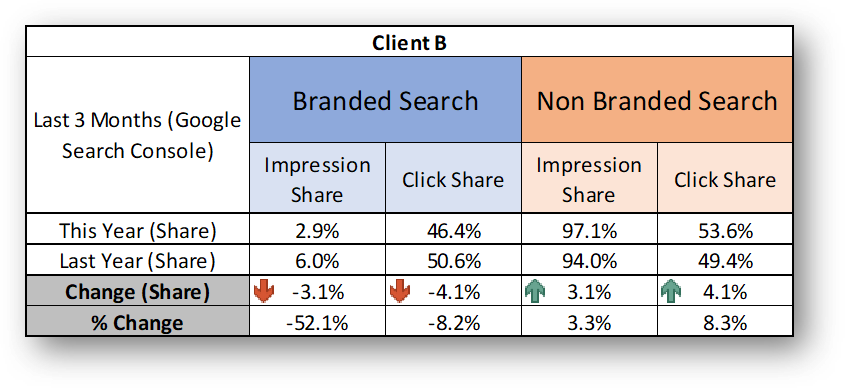 Time to ask for a raise for our content writer! Or perhaps we can slow down our content creation efforts for a period and instead focus more budget on awareness driving efforts.
Time to ask for a raise for our content writer! Or perhaps we can slow down our content creation efforts for a period and instead focus more budget on awareness driving efforts.
How Can You Get More Non Branded Organic Traffic?
Google (and other search engines like it), are always looking to match up search queries with relevant, trustworthy, and helpful results on the SERP. Here are 5 principles to keep in mind, and what that means for your non branded organic traffic.
Non Branded Organic Traffic Principle 1: Users Must Be Actually Searching for Your Topic
If you’re creating content that you want users to find in organic search, it’s important that users are actually searching for the topic you’ll write about. This seems pretty elementary, doesn’t it? But many content creators still neglect to conduct detailed keyword research. Don’t be one of them.
There are lots of free keyword tools out there (top recommendation: check out ubersuggest on this list of 6 recommended free SEO tools), and you can use them to discover keywords that are the best opportunity. What’s a good opportunity? You should be looking for keywords with relatively high search volume and relatively low competition. That’s the best way to find non branded keywords that can yield meaningful non branded organic traffic.
Non Branded Organic Traffic Principle 2: Clusters of Content are More Powerful Than One Off Pages
When it comes to creating content, it’s harder to get first page Google rankings if you have only a single page dedicated to the topic as opposed to multiple pieces of content all exploring the content from various angles.
Let’s say you wanted to rank for a keyword like “how to do SEO”. You could create one page on the subject. It would be possible, but not likely that this page would rank and drive non branded organic traffic to your site. On the other hand, you could create a “topic cluster” (also called a “content cluster”) about the same topic comprised of multiples pages on your site that are all held together through internal links. With the cluster approach, you might create a main page focused on your main topic (how to do SEO), that provides a summary of 4 key disciplines about SEO and then links out to 4 pages that explain each of those 4 disciplines in greater depth. When each of those 4 “supporting pages” (or “sub-topic” pages) link back to your primary page, Google will understand the associations between the pages and rank the pages of your cluster (especially your primary topic page) more highly.
Check out this video below for more on keyword research and how topic clusters work in practice.
Non Branded Organic Traffic Principle 3: Google Reads The “Name” of Your Links
Anchor next is the name of a link. Search Engines like Google read that anchor text to understand the destination of the link. So Google will use the anchor text of a link on Page A that links to Page B as a way to help understand the context of Page B.
This is one of the primary reasons that content clusters are so powerful. As each new sub topic page is created, the incremental internal link that goes from the sub topic page to the core topic page is one more signal to Google about the content of that core topic page. And that additional signal is one more reason to slowly increase the ranking of that page on the Google SERP.
Non Branded Organic Traffic Principle 4: Backlinks = Signals of Trust
Backlinks (also called inbound links) are links that originate on another domain and end up pointing to your domain. Google sees these links as votes of confidence going from the website giving the link to the website receiving the link. In that way, these links function as the currency of the internet, with the largest and most trustworthy domains becoming even larger and more trustworthy as the receive new backlinks from other domains.
Link building can be a slow and sometimes frustrating process. But it’s also a process that can yield powerful results over time. As the link profile of a website grows over time, the rankings of pages on that website will slowly rise. Building high quality links on a site elevates the trustworthiness of that site in the eyes of Google, and is the rising SEO tide that lifts all boats on that domain.
Non Branded Organic Traffic Principle 5: There is No SEO Without Amazing Content
It all starts and ends with content. The other 4 principles covered here are meaningless without it. You could have completed great keyword research and thoughtfully mapped your keywords into topic clusters connected with perfect internal links. But if the content is unoriginal, poorly written, too short, or otherwise weak, it won’t get you much. The same thing goes for your backlink profile. No other reputable website is going to want to link to your site if the content won’t be informative and helpful for readers.
Can You See Non Branded Keywords in Google Analytics?
Yes, you can see non branded keywords in your Google Analytics property. From your Universal Analytics (UA) property, check out the “Acquisition” reporting bucket. From there, click into the “Search Console” reports, and check out “Queries” as shown in red below. Please note: you will need to integrate your Search Console property with your Google Analytics property in order to be able to see this data in Search Console.
From here, you can see the query specific information for your organic traffic and sort to see branded traffic or non branded traffic. You can also search for specific non branded keywords by applying a filter and grouping all queries that include a specific term in the query string.
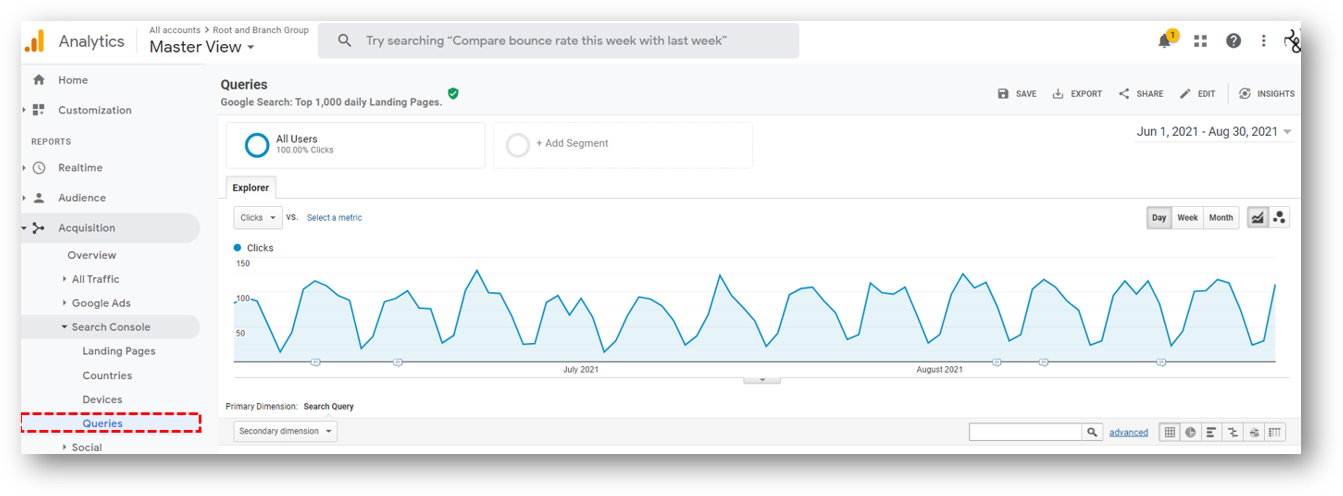
What Next?
Measuring and analyzing within Google Search Console should keep you busy for some time. There is a lot to learn from this powerful (and free!) platform. If you’re looking to ramp up your SEO and analytics game from there, review your measurement protocols for On Page SEO vs Local SEO, consider implementing button click tracking as part of your measurement plan, and dig into your sitemap with Yoast and Search Console.
And if you’re interested in talking about more digital marketing training, you can always get in touch here. Have fun out there!

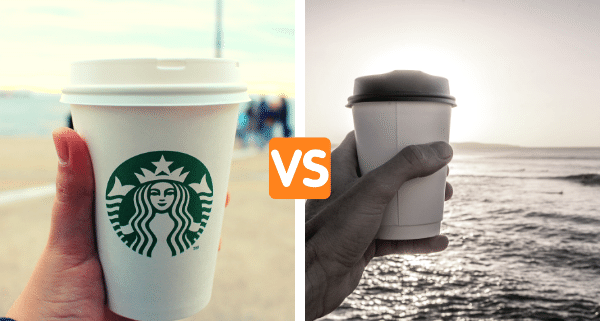



Hi,
First of all, I would like to say that I am a big fan of your blog.
I reach out to your site to offer a unique and valuable guest post.
Please tell me the criteria for publishing an article in your blog and if possible, also the requirement for inserting a link.
We look forward to hearing from you.
Kind regards,
As always my friend, this is superb!
Thanks Nick. Appreciate the feedback!